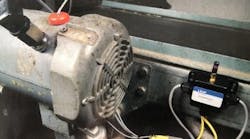It’s hard to argue against the core value proposition of wireless sensors. They offer plants and industrial machine builders a low-cost, easy-to-implement pathway to new information that can lead to major leaps in efficiency, better process control and less unplanned downtime. And while successful wireless sensor implementations often pay for themselves in a matter of months, a range of adoption issues can derail even the most promising initiatives.
Scott Dalgleish should know. He spent the early part of his career as a project engineer and maintenance manager for the food division of a major consumer packaged goods company. Today, as CEO of Phase IV Engineering, a 25-year-old company specializing in wireless sensing solutions, he’s brought that experience to bear in the development of the company’s new industrial Leap Sensor system.“The system was designed from the ground up to address the five biggest roadblocks to wireless implementation,” Dalgleish says. These include data security, suitability for specific application needs, the need to provide actionable “small” data, quick proof of concept and ease of installation, he says.
“Data security is often the first topic a potential client asks about,” explains Jake Baldwin, software/firmware engineer with Phase IV. The Leap system’s Thread network technology, an IPv6-based low-power mesh incorporates “banking class” security to ensure end-to-end security of data transmission. “Because each sensor is IP-addressable, we can use the same encryption technologies that you use when doing your online banking,” Baldwin says. “Because encryption occurs between the server and the sensor, even the gateways don’t understand the messages they’re passing along.” This level of end-to-end security assurance quickly defuses any cybersecurity concerns, Dalgleish adds.
The Leap Sensor system addresses roadblock number two, suitability for specific application needs, with highly modular hardware and firmware that can be quickly adapted to particular requirements, such as a new sensor input, alternate radio technology or communication protocol. “Off-the-shelf solutions often don’t quite fit, yet a custom-engineered
system is out of reach for most small to medium manufacturers,” Dalgleish says. Because of the system architecture’s high modularity, Phase IV can add a new sensor type in as little as two to three days. Modular firmware also makes it easy to use different wireless radios. For example, transmitting data straight to cellular. “And it’s the same secure connection over wireless or cellular,” Baldwin adds.
Further, the sensor electronics are rated from -40°F to 250°F operating temperature, an unparalleled range that can be extended further with special enclosures, Dalgleish says. Demonstrating the Leap Sensor system’s extreme flexibility, the company has created a 5mm-thin package that attaches to the top of a silicon wafer. Nine RTDs monitor in-process temperatures as the wafer moves through ovens and other critical fab equipment. Another common configuration is a motor monitoring sensor comprised of a single transmitter connected to temperature, electrical current and vibration sensors (photo). The transmitter houses not just a wireless radio, but a powerful, multi-threaded processor as well. It takes all that “big data” generated by the sensors, and sends only processed “small data” such as an alarm or completed FFT analysis onward to the gateway. Multiple sensors per transmitter also lower the cost per sensor.
The final roadblocks that Phase IV is attempting to address with its Leap Sensor system have to do with proving and delivering value—and doing so quickly and easily. The company has a “concept” multi-sensor transmitter that supports a broad range of sensors. This allows the company to deliver a fully functional, proof-of-concept system in a matter of two or three weeks. “After a positive experience with the proof-of-concept system, it’s much easier to justify a full system tailored to their specific parameters,” Dalgleish says. Finally, that customized solution is 100% factory configured so that the system is ready to run out of the box, Dalgleish says. “Most sensors systems can be up and running, transmitting data within 5-10 minutes.”




